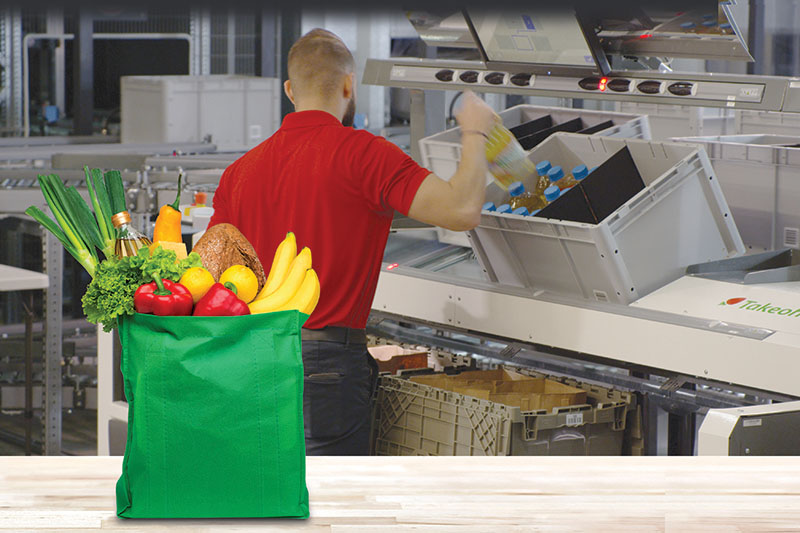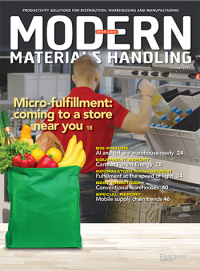Micro-fulfillment may be coming to a grocery store near you. See how it works.
Forget 500,000-square-foot—or even 50,000-square-foot—distribution centers. Materials handling automation and technologies are the next trend in brick-and-mortar fulfillment.
The scene looks familiar to anyone who has walked through a facility handling automated e-fulfillment: Associates at a goods-to-person workstation pull product from a donor tote delivered from a shuttle system and use them to build customer orders received online.
But there’s a twist: This isn’t your typical 500,000-square-foot distribution center, or even a 50,000-square-foot distribution center. Rather, the solution from Takeoff brings together Takeoff’s software with a shuttle system from Knapp in a 10,000-square-foot space in the back of a grocery store.
In a typical installation, Takeoff manages some 15,000 SKUs in the shuttle system, including a refrigerated lane, representing about 80% of the items most often ordered by customers online. The fastest moving items are picked manually from shelving adjacent to the shuttle system, while store personnel pick bulky items (think toilet paper or dog food), fragile items (think bottled water), frozen foods, deli items, produce, and seafood and meat as well as the slowest moving products from store shelves. Those items are married with orders in the back.
According to Lucia Brower, Takeoff’s chief of staff, the company can implement a solution in less than 20 weeks after the space has been prepared. Once it’s in operation, “we can typically fill an order for 60 items in a matter of minutes rather than an hour for an associate to go through the store with a cart,” Bower says.
The industry calls it micro-fulfillment. It could be the answer retailers and grocers have been looking for to quickly and economically fill Buy Online/Pick Up in Stores orders, or BOPUS. While grocery is the earliest adopter, other retail segments, including Big Box retailers, are investigating different solutions to turn their brick-and-mortar space into mini DCs to serve the local market.
The drivers for this trend: Pure play e-tailers, and the 3PLs that work with them, are building out networks to get closer to the customer for next-day and same-day delivery. Meanwhile, grocers and retailers want to capitalize on the infrastructure they already have in place in their stores. But, that doesn’t come cheap, notes Matt Inbody, Dematic’s chief disruptor. “Grocers tell us it costs about $5 to get the typical order to the curb if you or I pick the order,” Inbody says. “They’re spending about $15 to pick an order that you or I place online for pickup in the store. That $10 gap is often tied to labor.” That $10 gap also represents a good chunk of the grocer’s profit margin on an order. With micro-fulfillment, a grocer “can still have a DC that serves a city, but now they have 20 or 30 retail locations in an urban area that can serve as their forward pick location,” Inbody says.

Grocers and retailers are piloting semi-automated, voice-enabled pick-to-cart solutions (right) as well as pick-to-robot solutions (left) in the store, in back rooms and dark stores.
Both 3PLs and solution providers are getting in the game. That was evident in our feature on Rakuten Super Logistics in the September issue of Modern Materials Handling. Similarly, Tel Aviv-based CommonSense Robotics is building highly automated, multi-tenant micro-centers in urban areas that the company says are less than 6,000 square feet. And, other system integrators are bringing solutions to the market to compete with Takeoff and Knapp, including Tompkins Robotics, Dematic, 6 River Systems, IAM Robotics and Swisslog and AutoStore, which are developing a solution for a grocer. Expect more to follow.
At the same time, this is an emerging space. While Takeoff is in talks with a number of grocers and has implementation projects on the calendar, currently six sites are up and operating in North America and Australia, according to Bill Stenger, who is the director of food solutions for Knapp. But, hey, that’s six more than the other solution providers we spoke with have in operation as of this writing, at least in the United States.
And, as Stenger notes, having implemented six, Knapp is using that experience to develop iteration 2.0. You get the sense that we’re in the “throwing stuff against the wall to see what sticks” stage. “There’s a lot of experimenting going on right now,” says Tom Galluzzo, chief technology officer for IAM Robotics, which has participated in some of those experiments. “It’s safe to say that there’s a lot of figuring out what might be the right approach and strategy, and that no one’s figured it out.”
“There’s no question that we’re beyond the starting gate,” adds Kara Ashby, president of Sedlak Supply Chain Consultants. “The technologies are there. Robotics are there. There are mobile apps, and people are ordering online to pickup in stores. Now, the industry is trying to pick the winners and losers and figure out who’s going to survive as the market matures.”
From Modern’s interviews, we identified three emerging strategies, and they’re similar to picking strategies in larger DCs: Conventional pick to cart from store shelves; semi-automated pick from shelves in a back room or dark store; and highly automated solutions like those from Takeoff, Knapp, Dematic and Swisslog/AutoStore. Here’s how it’s all shaping up.
Strategy 1: Good old pick to cart
By all accounts, most micro-fulfillment is pretty basic today. Store associates push a grocery cart through the aisles and pick to paper grocery bags. Taking that one step further, some grocers are now using purpose-built carts that can hold 10 or 12 bags and get more orders from one associate’s trip through the aisles. But, that picking is mostly paper based and labor intensive.
The next evolution is to replace paper-based picking with voice for hands-free picking, along with software to optimize the fulfillment operations. Retailers and grocers in Europe, including the United Kingdom, are already using voice, says Andrew Southgate, the global vice president of sales and marketing for Lucas Systems.
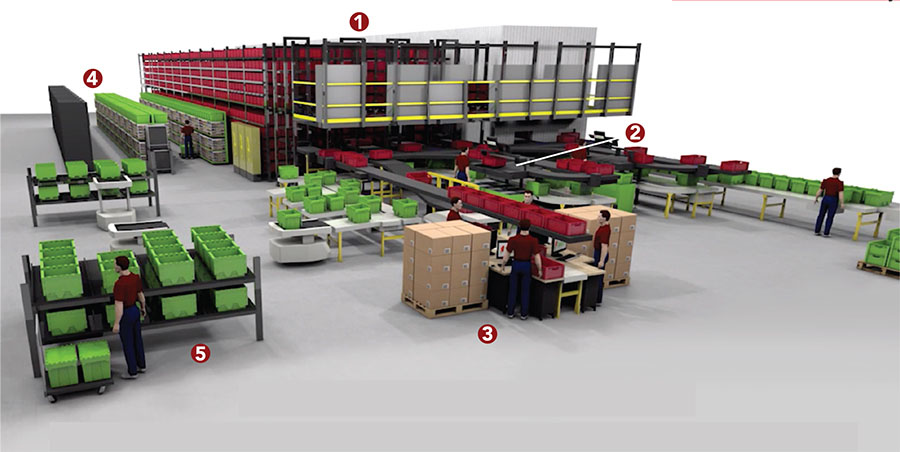
How does micro-fulfillment work?
There are several models for grocery micro-fulfillment centers (MFC) coming to the market. The solution from Takeoff Technologies and Knapp, one of the early movers in this space, is pictured above and works like this. Solutions like this will generally fit in an 8,000- to 12,000-square-foot area, which could be the back room of a grocery store or an addition to an existing store. Early adopters are using one MFC to service a cluster of stores.
Totes are inducted into the shuttle system (1). Automation is used for about 80% of the SKUs most frequently ordered by online customers. Typically, there might be two lanes of ambient storage and one lane of refrigerated storage.
Orders are filled at goods-to-person workstations at the front of the shuttle system (2). Once an associate withdraws the needed items from a donor tote, it’s automatically returned into storage.
The fastest-moving items can be picked from pallets (3) or from a shelf area to avoid constantly replenishing the shuttle system.
Fragile and crushable items, as well as some frozen items, can be picked from shelves and freezers in another work area (4).
The slowest moving items as well as deli, meat and seafood products and some fresh produce may be picked in the store (not shown).
Orders are then aggregated (5) and delivered to the front of the store for customer pick up, or loaded onto a trailer to be delivered to other stores served by that MFC.
“There are two challenges if you’re filling customer orders in your store aisles,” Southgate says. “You need to stay out of the way of the regular customers who are doing their shopping, which means you don’t want an associate staring a lot at the screen, and you want the least travel distance for the picker to speed up the picking process.”
The solution that Lucas is bringing to the market does both. Voice directs the order selectors activities on the floor similar to the way voice directs pickers in a warehouse. Voice can be combined with RFID-enabled smart shelves that can confirm the picker is at the right shelf location while a voice check-digit confirms that the right quantity of item was picked, again just like in a warehouse.
The second component is software informed by algorithms that can sequence the picking around cutoff times that ensure that orders are ready when a customer arrives for pickup. The software also uses a digital version of the store layout to optimize the travel path. And, the software can run on a smart watch that connects to the headset by Bluetooth rather than a bulky mobile computer. The Holy Grail, Southgate says, is to use the system for the full gamut of activities in the store, from receiving merchandise in the back room to putting it out on the shelf to filling orders. He adds that no one is doing this now.
Strategy 2: Semi-automation is the next step
The semi-automated solutions coming to market are scaled down versions of the solutions showing up in e-fulfillment centers. They include pick to cart or pick to a robot in the back room or a dark store and may also incorporate automated sortation to quickly consolidate orders.
For example, 6 River Systems is developing a mobile robot and cart solution for use in a retail back room. The picking process begins when the robotic control system receives a batch of orders from a warehouse management system (WMS). The robot system turns those into customer orders and then determines which SKUs should be put into which grocery bag, based on criteria such as the maximum weight for a bag, crushability and whether items need to be segregated by temperature. Once an associate scans into the system, a robot leads the associate through the aisles in the most efficient manner for the items to be picked. The system displays the exact bag on the cart for a specific item. Picks are confirmed by a scan. While the system could be used in the store, “we’re seeing more demand for dark stores and back rooms because the safety considerations are similar to a traditional warehouse,” says Fergal Glynn, 6 River’s vice president of marketing. In the case of IAM Robotics, which makes autonomous piece-picking robots, the robot would pick from a shelf to a tote and then deliver the tote to a consolidation point.
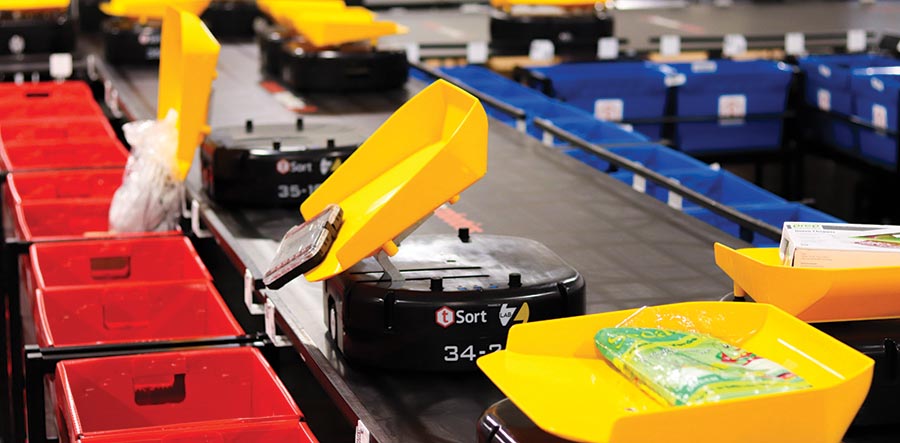
Mobile robotic solutions, like the one pictured here, allow grocers and retailers to sort orders that are batch picked in the store or a back room.
If the items are batch picked in the store or a back room, the items need to be sorted and consolidated into customer orders. Tompkins Robotics is tackling that problem with a system that uses what are essentially mobile tilt trays that move across the top of a platform to deposit items in the right location for an order. The platform is modular and portable; a standard section measures 1 meter wide by 3 meters long, is on wheels and can be bolted together in different configurations to accommodate the contours of a back room. The whole thing plugs into a standard 20-amp outlet and doesn’t require a sprinkler system.
A new model?
Micro-fulfillment represents a new order fulfillment model. It also represents a new business model for the solution providers entering this space. “Right now, our model is built around getting a large number of robots into a small number of warehouses,” says Fergal Glynn, vice president of marketing for 6 River Systems. “Now, we’ll need to get a small number of robots up in running in a lot of grocery stores.”
That means managing more implementation projects—projects that need to get deployed and running far faster than the typical 12- to 18-month project in a traditional DC. It might also mean building to stock so systems are ready to go when there is an order. “Right now, we’re engineering and manufacturing systems for 50 sites, which is an organizational shift,” says Bill Stenger, director of food solutions for Knapp. “We now have a 50,000-square-foot facility to inventory the systems. That’s a new supply chain challenge.”
These systems are going to need to be supported, since skilled maintenance people aren’t generally on staff at retail and grocery stores. “If you’re putting a piece of automation in the back of 30 or 40 retail stores, you have to have someone who can show up and keep them running,” says Matt Inbody, Dematic’s chief disruptor. “Solution providers who already have a service network will have an advantage.”
The final hurdle might be how retailers finance the systems: Will the time and labor savings be enough to deliver an ROI? “I think the winning solution will come down to capital versus operations,” says Patrick Sedlak, a principal with Sedlak Supply Chain Consultants. “I also think that when it comes to back rooms and dark stores, the robot-as-a-service or automation-as-a-service model is going to have a leg up.”
“Someone can pick the items for 200 orders, and have the machine control the accuracy and speed,” says Mike Futch, president of Tompkins Robotics. The system also has the capability to sort items that require special handling to specific destination points, such as fragile items or fresh fruit. While the solution was developed for order consolidation, Futch’s team is now adapting it for other back room tasks. Those could include sorting newly received items according to where they’re going to be stored on the store shelf or sequencing orders for a postal delivery route. “We could have a super center receive a batch of items from a distribution center and then sort them into orders to be picked up in the store or sequence route delivery for next-day delivery,” Futch says.
Strategy 3: High-speed automation
Order fulfillment is moving to “edge fulfillment,” in the words of Dematic’s Inbody. He defines that as fulfillment as near as possible to the customer’s doorstep, adding that “our job is to look at the pieces of automation that will provide that.”
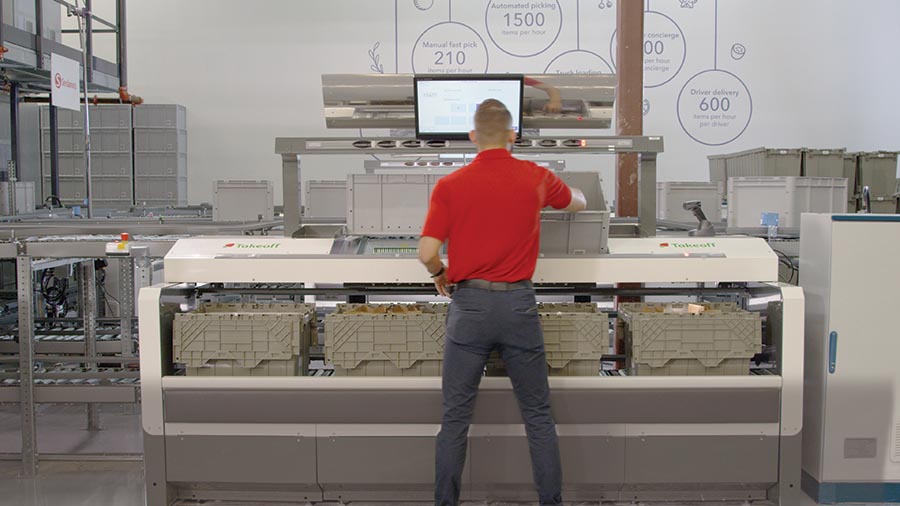
Using automated storage and goods-to-person picking, an associate can fill a typical customer order in a fraction of the usual time.
That is leading to highly automated solutions using shuttle systems, in the case of Knapp and Dematic, and robotics in the case of AutoStore. All three solutions incorporate refrigerated storage. “It’s very similar to a traditional warehouse, with batch picking, bulk picking and order staging,” says Knapp’s Stenger, “but it’s scaled down to maximize the footprint.” Stenger adds that Knapp spent about two years figuring out which SKUs were right for the automation, which should be picked manually and to optimize the size and height of the totes. Frozen food just doesn’t work, at least for now. Receiving and replenishment is done in non-operational hours. “Takeoff releases the orders to our control system, and then we pick them based on a pickup window that meets customer expectations,” Stenger says.
Similarly, Dematic announced its micro-fulfillment solution in September at its Material Handling & Logistics Conference.
It is designed to handle grocery, but Inbody says the company is also in discussions with general merchandise retailers—think Big Box—and parts suppliers, like auto parts. “We’re not changing what we do,” Inbody says, “we’re just moving the walls of the DC to the store.”
In its first iteration, Dematic is basing its solution off of a shuttle system, but Inbody expects that to evolve to include other technologies in the future. He says his team is also looking at how to prep material back in the DC “in a better way into the store to place it in that ‘big vending machine’ in the back room. If I can bring the material into the store in pre-configured totes that can slide right into the shuttle system, that’s going to make everything work better in the store.” Inbody also envisions using the solution to replenish store shelves.
As we noted earlier, this is an emerging area with lots of interest, but also a variety of solutions being proposed. Which solution will emerge as the best is still unclear, as Sedlak’s Ashby says. What’s clear is that the retailer or solution provider who figures this out will have a competitive advantage when it comes to pick up in store or same-day delivery. “When someone figures this out, there’s going to be a leader,” says 6 River’s Glynn. “Someone doing a pilot today is going to learn from that experience and then get their solution into hundreds of stores.”
Companies mentioned in this article:
- 6 River Systems
- Autostore
- Dematic
- IAM Robotics
- Knapp
- Lucas Systems
- Sedlak Supply Chain Consultants
- Takeoff
- Tompkins Robotics

Article Topics
Inventory & Picking News & Resources
Siemens, Universal Robots, and Zivid partner to unveil smart robotic picking solution AI-based inventory monitoring solution provider Gather AI raises $17 million NRF 2024 retail sales forecast calls for growth Swisslog gives live demonstration of ItemPiQ latest evolution Cimcorp automates fresh food distribution with flexible storage, order picking solutions ABCO Systems acquires FastFetch The Ultimate Guide to Reducing Warehouse Travel More Inventory & PickingLatest in Materials Handling
Registration open for Pack Expo International 2024 Walmart chooses Swisslog AS/RS and software for third milk processing facility NetLogistik partners with Vuzix subsidiary Moviynt to offer mobility solutions for warehouses Materials Handling Robotics: The new world of heterogeneous robotic integration BSLBATT is looking for new distributors and resellers worldwide Lucas Watson appointed CSO for Körber’s Parcel Logistics business in North America Hyster recognizes Dealers of Distinction for 2023 More Materials HandlingAbout the Author
Subscribe to Materials Handling Magazine

Find out what the world's most innovative companies are doing to improve productivity in their plants and distribution centers.
Start your FREE subscription today.
April 2024 Modern Materials Handling

Latest Resources


